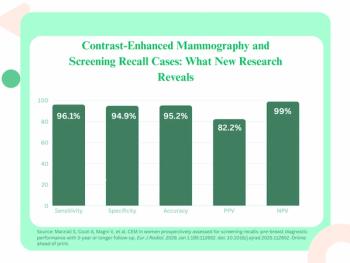Welcome to Diagnostic Imaging. I’m senior editor Whitney Palmer. We’re back with you this holiday week to bring you some of the highlights of this week’s radiology news.
This week saw a flurry of news about developments with MRI.
In a study published in the journal Radiology, researchers from Germany used 3T MRI scanners to scan the neocortex, the heavily grooved outer layer of the brain that is integral to language, conscious thought, and other functions, for iron levels. Historically, the neocortex has been difficult to impact because its anatomy prompts distortions, signal decay, and artifacts in MRI scans. However, in this study, investigators were able to show, by comparing patients with Alzheimer’s to healthy participants, that iron levels were higher in the whole cortex for patients with Alzheimer’s, revealing the association between high iron levels in the brain and cognitive deterioration independent of the loss of brain volume. Additionally, the researchers said, their findings point to the possibility of using chelators – iron-reducing drugs – as a potential therapy for Alzheimer’s.
A second study, published this week in Cancer Research, detailed how an existing MRI technique called T1 mapping could potentially be used to whether children have a particularly aggressive type of cancer – neuroblastoma – and whether the treatment is working at an early stage. Though their current research was conducted in mice, investigators from the Institute of Cancer Research in London said their findings could be applied clinically. In the study, the team used T1 mapping MRI scans to map different tumor cell populations and compared them to maps created with artificial intelligence. They discovered areas with high T1 values corresponded to areas with more aggressive cancer cells, and lower T1 value spots were more benign. They also used T1 mapping to determine the efficacy of two neuroblastoma-targeting drugs, alisertib and vistusertib, and they found that when the drugs succeeded, T1 measures dropped. Their hope, they said, is that this technique can be used to both improve treatment for aggressive cancer and limit the medication side effects children experience by minimizing their exposure to drugs that might not be working.
And, a third study, published in NeuroImage, a team from the University of Maryland, Baltimore County, detailed a new image analysis method called independent vector analysis for common subspace extraction (IVA-CS) that can be used to categorize fMRI data based solely on brain activity. Clinically, it can help providers treating patients with schizophrenia by grouping patients based on their brain imaging alone. Treatment for schizophrenia is not a one-size-fits-all endeavor, so this data, they said, can be used to just whether a treatment is working, potentially leading to a change in therapy is a patient is seeing no improvement. The investigative team has a plan to researcher this method’s efficacy with addiction and substance abuse in adolescents.
Across the country, academic medical centers and community hospitals are beginning to see a steep spike in their numbers of COVID-19 patients. Consequently, triaging and managing these patients has become an ever-more critical task as resources and personnel begin to stretch thin. One institution in this position is University of Texas Health in San Antonio. Within the past two weeks, the health system has seen a quadruple increase each in their number of diagnosed COVID-19 cases, the number of patients hospitalized, and the number of patients on ventilators. Diagnostic Imaging spoke with Dr. Nilam Soni, director of the Point-of-Care Ultrasound Training Program in the South Texas Veterans Health Care System associated with University of Texas Health, about the role this bedside modality has increasingly played in how they are handling this growing patient volume. Here’s what he shared.





























